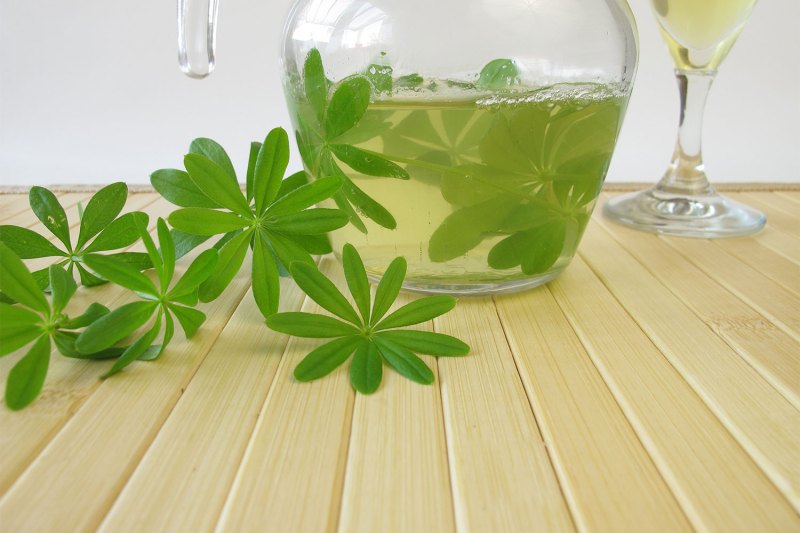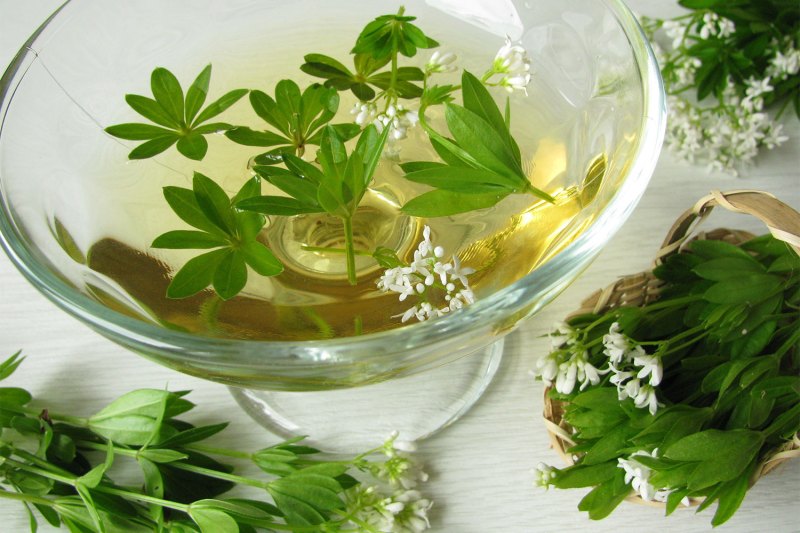From Spanish sangria and tinto de verano to Italian Aperol Spritzes, summery wine cocktails are a common sight in southern Europe … which makes sense, considering the mild Mediterranean weather and the top-notch wine regions located throughout this stretch of the continent. But if you focus your attention a little farther north, you’ll discover a fruit-forward and herbaceous white wine punch that’s crisp and light enough for even the hottest July afternoons. It’s found in Germany (another European nation with a vibrant wine scene), and it’s known as
.

What is maibowle?
Maibowle, which translates to “May wine,” is a punch made with white wine, seasonal fruit, and — perhaps most notably — sweet woodruff, a unique herb that’s native to many regions of Europe but can also be planted in the U.S. When asked to describe the flavor of sweet woodruff, co-owner and head mixologist Stefan Huebner of Dot Dot Dot in Charlotte, North Carolina, a German-American who grew up watching his mom enjoy maibowle on a seasonal basis, tells us that sweet woodruff “has a flavor of hay and is slightly bittersweet.”
Maibowle makers can add supplementary ingredients to the traditional formula; brandy is a popular maibowle extra, and Huebner likes to top his off with dry sparkling wine. But the choice of a base white wine and the acquisition of sweet woodruff represent the most important aspects of a successful maibowle.
Where can you find sweet woodruff?
Sweet woodruff grows harmoniously in many U.S. climates, so if you’d like to secure your own regular supply of this herb, then you’re probably best served by planting it yourself. Seeds and plants can be found at many garden stores.
Sweet woodruff’s peak growing season occurs during the mid-spring, so if you’re interested in whipping up a bowl during the summer and don’t already have a supply of fresh sweet woodruff harvested, then you can use the dried stuff instead. It won’t pack the potency of the fresh version, but you’ll still manage to get those compelling botanical and slightly citrusy notes. Dried sweet woodruff can be purchased at herb shops and on online platforms like Etsy.
Although sweet woodruff’s distinct flavor is a major feature of traditional maibowle, there’s certainly nothing stopping you from swapping in different herbs of your choice, should you wish to explore different taste profiles. Lavender, chamomile, and lemon balm will all lend intriguing notes to your maibowle, but feel free to play around and find an herb blend that best suits your tastes.
Which wines work best for maibowle?
Maibowle includes white wine as its base, and Huebner tells us that, “I would suggest using dry wines to stay authentic to its origins. I would pick a German dry Riesling.”
Riesling sometimes suffers from incorrect assumptions about its flavor profile; because some versions of this wine are sweet or off-dry, many drinkers figure that all Riesling has a high sugar content and fits into the “dessert wine” category. However, plenty of wineries throughout Germany, Austria, France, and the United States specialize in dry Rieslings defined by a crisp texture, notable minerality, and zingy acidity. These Rieslings play beautifully off of the herbaceous notes and hints of citrus in this punch, and we especially recommend these three reasonably priced bottles:
- Ulrich Langguth Riesling: A dry, crisp Riesling from the Mosel region of Germany with recognizable citrus notes and a refreshing profile. It usually sells for $15-20 per bottle.
- Trimbach Riesling: The Alsace wine region is technically located in France, but its position on the German border produces wines with a close kinship to German varietals, including a number of top-notch Rieslings. Trimbach Riesling features a blend of fruit and spice notes and a substantial level of minerality, and it sells for an average price of $20 per bottle.
- Atwater Estate Vineyards Dry Riesling: The Finger Lakes region of New York yields some of the finest New World Rieslings out there, and the version made by Atwater Estates brings stone-fruit flavors to the forefront, resulting in a summer-perfect dry white that works beautifully in the context of maibowle. Atwater Estate Riesling can be purchased for around $15 throughout New York state.

Stefan Huebner’s Maibowle
When making maibowle, Huebner opts for a dry Riesling base, and he also incorporates lemons, limes, simple syrup, sweet woodruff, and a sparkling-wine float on top. He offers a few pieces of advice for maibowle newbies: “I would chill the Champagne and the [Riesling] before use, so you can avoid using ice and diluting the drink. [Also], I would slap and tear the woodruff and put it into a small fine mesh strainer, then pour your wine through it into the punch bowl. [Then,] garnish with the fresh, attractive woodruff.”
Ingredients:
- 2 bottles dry Riesling
- 1 bottle Brut Champagne
- 6 oz sweet woodruff leaves (4 oz shredded and 2 oz for garnish)
- 8 oz simple syrup
- 1 lemon, cut into wheels
- 1 lime, cut into wheels
Method:
- Shred 4 oz sweet woodruff and place into a fine mesh strainer.
- Pour both bottles of Riesling through the strainer into a punch bowl.
- Add simple syrup and top with Champagne.
- Garnish with lemon and lime wheels and 2 oz sweet woodruff. Serve cold.



